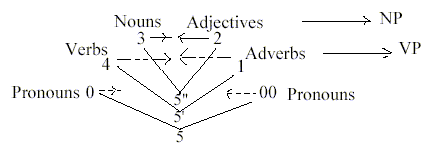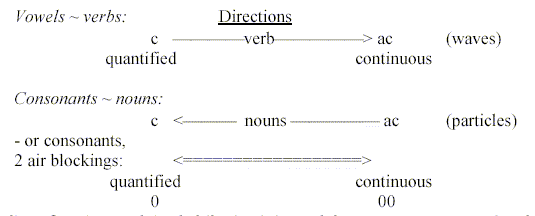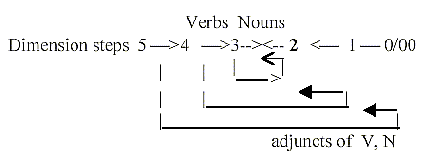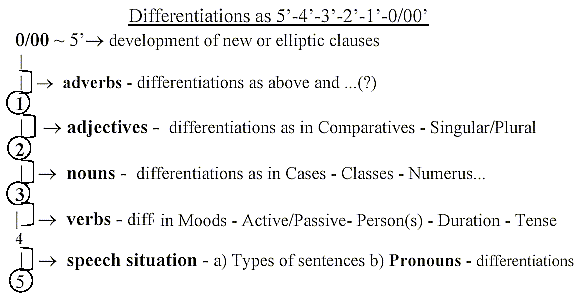|
Geometry at bottom:
1. The basic character of main word classes as verbs, nouns
and adjectives is here traced back to the features of dimension
degrees (d-degrees) 4 - 3 - 2 in the dimension model, at
bottom geometrical:
- Verbs as originally with the character of vectors,
d-degree 4,
- Nouns signifying closed units, "mass units"
in d-degree 3,
- Adjectives separating nouns, possible to identify
as originally indicating the surface of nouns, d-degree
2.
- "How"-adverbs
from adjectives. About adjectives and adverbs, see
below.
This view on the different word types
is of the same kind as the philosopher Kant called "categories
of aspects" on the world and saw as given in human
brains.
2. Also linguists talk in terms of geometry.
Closer similarities seem to exist with Roman Jakobson's
analyzis of the 8 cases in Russian according to a description
by Beard (LB) (RJ, p. 60), in concepts as
"direction", "extent" (size) or "volume"
and "border, periphery". How Jakobson's 4th concept
"ascription" (Russian "nadelitenost")
shall be interpreted, is a bit unclear in this reference,
= "attributed" (?). Note that the descriptions
here concern a sub-category of nouns.
Beard himself talks about "earlier
word stems with mostly geometrical meaning which have been
reduced to a parasitic existence".
3. It would be reasonable to believe that the analysis
of both a situation which gives the Meaning and heard language
from outside had similarities with how the eye and the visual
centre in cerebrum analyzes visual impressions from outside
into basic geometrical forms, for instance in direction
(vectors), distance to centres (amplitudes), angles, straight/bent
etc.

There are also sensory nerve cells that only get activated
by changes, i. e.. are of a derivative kind.
4. This geometrical analysis could explain confusions by
persons with lesions in linguistic centra of the brain.
The mix of snow and salve, for instance, or man with poncho
with a spruce fir, with two examples collected from a detective
story.
5. Compare too that Chinese is said to separates noun classes
of spatial versus flat objects, of spread out versus long
and narrow objects.
6. Debranching of d-degrees:
Our dimension model implies that lost degrees of structure
in directions outwards may meet the "other way around":
from step 5 → 4 one d-degree,
from step 4 → 3 second d-degree:
The "Loop model":

The opposite directions will meet in the middle of step
3 → ← 2:

With a perpendicular view on this figure, we may rewrite
it as in three polarizations of d-degree 5:
5" →
3<—> 2
5' → 4
<—> 1
5 → 0
<—> 00
We get a figure like this, which also may give a basis (or
reason for) the main division of sentences in VP, verb phrases,
and NP, noun phrases, of the Chomsky school:

(In his figure we have what here is called the "haploid"
version of a dimension chain with a term from biology,
where start 5 and end 0/00 are replaced by pole 0, the
centre and 00, the anticentre.)
D-degree 5 is in the model regarded as the ultimate, underlying
binding force in lower d-degrees - and lower d-degrees are
defined as polarizing forces in relation to higher ones.
With the aspect of debranched degrees, we may imagine how
components semantically included in the whole "Meaning"
or Sense, may become separate expressions for outer relations
between parts of the sentence.
It gives a basis for the debranching or separation of what
is called "form words" or particles
as suffixes - or prefixes, infixes and prepositions,
case signs etc. That's quanta as "carriers" of
the binding force in Syntax, expressed in physical terms.
An evolution has been going on it's said
towards "more and more of free form words" and
"movability of the form elements",
characteristic not only for Indo-European languages but
also for Semitic languages and in Chinese.
In terms of our model it implies a trend
towards lower d-degrees and superposed levels where more
and more d-degree steps as relations get quantified and
"substantivized" to separate units.
Verbs - Nouns

Bow - bow - bowed: verb - noun - adjective
1. The verbs as vectors represent primarily radial structures,
the relations of the subject to its surroundings, to other
units; the nouns or the substantival primarily circular,
demarcated units.
2. This main polarity may be founded in the nervous system,
in the opposition between frequency modulated signals
outward from the cells and the amplitude modulated
signals inwards the cells. Cf. frequency related time
in waves, connected with processes - verbs. And amplitude,
a spatial quantity, related distance as height, connected
with volumes - nouns. (Incoming signals have a circular
spread in the cell membranes.
3. Hence, we may see the verbal character as primarily
expressing directions and forces (vectors, d-degree 4 or
4→3) and the nouns as demarcated,
located, "substantiated" units in d-degree
3 or step 3→2. The difference
corresponds to the concepts of Forces in d-degree 4 versus
Mass in d-degree 3 in the first identification of physical
qualities in a dimension chain.
D-degree step 4 →
3 implies a step towards "circular structure",
a way towards differentiation and demarcation: the nouns
get precipitated.
(The essential question how pole 4a,
inward direction in our model, transforms to a circular
pole in d-degree 3 is also related to the question why
bodies rotate, both in micro- and macrocosm. It's perhaps
illustrated in a car engine and depending on the centre
displacement of the inward direction, expressed in very
generalized terms. This both astronomically, mechanically
and in certain centre displaced personalities.)
4. Original word stems were mostly verbs in Indo-European
and Semitic languages, which then developed into nouns (LB).
Grow - grass - green for instance
derive from the same root with the basic meaning something
like "shoot up".
In Ural-Altaic languages mood and tense
forms as first differentiation
of verbs were in reality nominative stems derived from
verbs (BC), hence followed the same direction outwards
as the development verbs →
nouns.
5. In Etruscan the same morphemes or phoneme combinations
developed to verbs and to nouns according to the linguists
(AP) - and presumably the same applies to many other
languages.
Compare "eat" in Thai language
= eat rice (kinkhhao), a word which has to be disintegrated
into parts if other nouns - or verbs - objects should be
referred to. * (See a note below.)
6. We have also that a verb can stand alone in a sentence
as an imperative: "Run!". A noun not. In
this sense verbs get closely related to first primary types
of sentences, and this in turn to moods as a first differentiation
of verbs. On the psychological level connected with "aim",
"will" as inner direction.
7. The main relation verbs - nouns may be interpreted
in three different ways in a dimensions chain
of word categories:

- In d-degree 4 the verbs with open structures represent
vectors outwards/inwards in relation to nouns in d-degree
3 or step 3-2.
- In d-degree step 3 - 2, which in simple geometrical
terms implies a polarization into radial versus circular
in our model, the verbs appear as radii, the radial "pole"
versus nouns as the circular, enclosing one. As radii the
verbs become relations between e. g. subjects and objects.
- In a d-degree step, as 4 →
3, one d-degree is debranched in the structure and translated
to external Motion, that is d-degree 0/00. (A main
feature of our model, if not meeting as d-degree 1 "the
other way around" inwards.)
Remember that outer poles of d-degree 4 are 0 and 00, (centre
- anticentre), defining the quality Direction, which meet
in last d-degree 0/00 of motions.
Hence, in a 3rd aspect verbs may represent linear "pathways"
(of d-degree 1) or these polarized into expressions for
Motions as such. (4→3+1,
1→0/00)
8. This 3rd aspect on verbs as words for motions may be
regarded as a consequence when the noun (as subject or object)
is singled out and named, is "substantiated".
Its complement becomes a word for motions, course of events,
processes.
9. Verbs as vectors, verbs as radii, verbs as motions: Irrespective
of which of the interpretations of the relation verbal -
substantival that in a certain context seems most valid,
they are all three complementary in the sense of
the model but in different ways:
- as higher d-degree versus lower (also
a 0-00-relation),
- as complementary poles of the same d-degree
3, or
- as structure versus motions.
(The dimension chain for Motions become opposite directed
versus the one of Structure in the basic form of the dimension
model.)
10. As the field level in physics is regarded an underlying
binding forces between substantiated mass particles in lower
d-degree, so (transitive) verbs act as "binding forces
between subjects and objects.
We may simultaneously regard the consequence
of the two gradients of the big linguistic level chain :
In the gradient where phonemes represent first centre, the
morpheme level will represent d-degree 4 and hence may polarize
into both the opposite poles of d-degree 3, nouns and verbs
as radii as pointed out above.
11. Vectors within an imagined circle give 3 aspects:
- directions outwards - inwards
- pointing out different points ("centra", things"
on the circle, in the surroundings,
the reference aspect,
- the property of being radii, connecting subject —
object (as centre — anticentre).
The first vector aspect could decide or be connected with
type of sentence - or order of words (~ directions) in the
sentence but also secondarily certain differentiations within
verbs as active/passive forms, 1st or 2nd person as subject
etc.
The pointing out of something in the surroundings
(on the circumference) as centre c2 implies for instance
demonstrative pronouns or articles - which in a simple geometrical
way then may appear as suffixes as terminal points for the
radii - a "suffix" with function of pronouns.
At the transition of verbs to the character
of radii, the relation itself between subject and object,
the vector property may have been debranched to prepositions,
primary words for directions and adverbial qualifiers.
12. Vowels — verbs:
Verbs as open structures, as vectors from a centre, may
in this respect be compared with vowels within phonetics,
with one centre, one inner (vibrating) catch or "gate",
and the nouns with consonants which also or only are defined
by a second outer gate or demarcation.
13. Arabic triplets of consonants are said to represent
the semantically demarcated sense, not "nouns"
but the "substance" of the meaning, while the
vowels are responsible for variations as in tense or persons,
what can be assigned to the syntax (LB).
It reminds of how vowels can be implicitly
understood in consonants as in Hebrew and other writing.
14. Why do we want a verb for a "full" sentence?
"It is beautiful". Why is? / - Of
the same reason that we need vowels between consonants to
get a word stem?
- Because there is pathways in our brains between stores
of pronouns or nouns?
- Verbs for transitions among stores of other parts of sentences?
Auxiliary verbs as "is", "becomes",
"would be"...
The least "whole" sentence would be a pronoun
(or noun) and a verb: He ran. (D-degree 0 →
4 in our model.)
15. There is also the elementary conceptual opposition
and complementarity continuous —
quantified:

Saussure wrote about points of syllable divisions: parts
of words with character of implosions and explosions respectively:
- implosions (~ inward direction), comparable with the way
from vowel to plosive: the air stream of the vowel gets
barred,
- explosions: the way from plosives to vowels, barred air
stream gets released. c →
ac, (~ outward direction).
——————————
A note:
It's possible to imagine complex word categories made up
of one transitive predicate with included object as first
"words". Compare the mentioned "eat"
in Thai language = eat rice (kinkhhao). In a hypothetical
morpheme aka = hunt buffalo the first two phonemes
could have developed to a verb ak-, for Swedish jaga
(= hunt), the two latter -ka to the word for Swedish
ko (= cow).
Departing from morphemes with potentially
both substantival and verbal sense, one could imagine two
series, 1) one series with verbs including objects, 2) one
series with nouns including predicates. The two series could
function as two crossing coordinate axes or "scales",
which leads to the "discovery" that all points
on one scale principally could be combined with all points
on the other. Something that leads to the ramification of
morphemes to verbs and nouns respectively, more "alienated"
linguistic categories.
———————————
Adjectives — Adverbs
Adjectives are here suggested as at bottom,
originally and sensorially of 2-dimensional character, as
surfaces of nouns. (D-degree 2 or step 2 —1
in second part of a dimension chain. —>
2 <—> 1.)

Properties of nouns and some determinations of verbs
are of course more or less included in the meaning of words
for nouns and verbs. They may be released from these and
become added as separate parts of sentences and own word
categories - when nouns and verbs become more generalized.
Mountain, hill, alp are different
nouns which in the words include different secondary properties
of height (c. amplitude) as adjectives. Walk, run
indicates different kinds of a person's motions in relation
to velocity (cf. frequency), corresponding also to adverbs
of manner.
As debranched d-degrees from higher steps according
to the loop version of a dimension chain, the adverbs and
adjectives get connected "the other way around"
with the verbs and nouns respectively.

Adjectives:
Adjectives may be regarded as polarizations of nouns. (Compare
that lower degrees in our model is defined as polarizing
forces in relation to higher ones.)
Secondary "polarizations" of
nouns such as in gender and "classes" of the type
living/dead things have also a roughly adjectival character.
Quality, kind, character - such that adjectives and
many adverbs represent - must be assumed as at least equally
primary categories as verbs and nouns from a semantic aspect.
In the beginning there was dark and light - in mythologies
but probably also for newborn babies. Compare morphemes
or phoneme combinations with virtual double sense of nouns
and verbs.
(Morphemes, in the gradient from phonemes
representing d-degree step 4 - 3 in our interpretation,
in the other gradient from the whole Meaning d-degree step
2-1, that's corresponding steps in the loop model.)
During the translation to sentences however,
they seem derived from verbs and nouns, in any case in Indo-European
languages according to SEO.
A linguist as Robert Beard (RB) distinguishes
5 main types of adjectives expressing qualities: three out
of verbs, 2 out of nouns. (In his description those derived
from verbs could be translated to "which does",
"which can be" or with participles, and those
from nouns to "which have" (a property?), "which
resemble".)
Note that adjectives as attributes cannot
be followed by pronouns in our languages at least, which
supports the view that pronouns don't originate from nouns
but originate from a more high-dimensional step.
The aspect of adjectives as the "surface"
of nouns, should be compared with the aspect in physics
where an atom may be analyzed in terms of pure shells also
the nucleus) as well as in other d-degrees. In the same
way a noun may be dissolved in its qualities and a "3-dimensional
body" be analyzed as aggregation of surfaces.
Atoms as "substantival" units
become in a deeper analysis "sewed up" of qualities:

Cf. that colours (and dark-light) originate
from jumps between orbits in electronic shells of atoms.
Perhaps such adjectives are primary ones? As electromagnetic
waves emitted by atoms bear witness to their structure,
the adjectives indicate the character of the nouns.
Adjectives in relation to nouns could also be interpreted
in analogy with the dual property of elementary particles
as electromagnetic waves and particles: the substantival
particle structure disintegrated, broken up.
 (Cf.
aspects in files about
physics. The wavy property becomes one expression for
the increasing degrees of motions in lower degrees of structure.) (Cf.
aspects in files about
physics. The wavy property becomes one expression for
the increasing degrees of motions in lower degrees of structure.)
As distinctions through comparisons by the sensory
nervous system adjectives may be regarded as a derivative
which describes changes in a "3-dimensional" curve;
the speaker as observer of relations. Cf. that there are
nerve cells that only get activated by changes, i. g. are
of the derivative type.
The polar character of elementary adjectives and
a lot of adverbs is obvious, the division in complementary
"poles" if expressed in terms of the dimension
model: - in words as dark —
light, in words for valuation as good —
bad, sick — healthy,
or in opposites as fast —
slow, first — last, late
— early etc., (As
we have "complementary" colours.)
Compare the physical concept "Charge",
polarized +/-, (and quarks "up" and "down")
proposed as a physical quality in d-degree 2 in relation
to Mass when analyzed as of d-degree 3 in this model.
In the dimension model the complementary "poles"
(or partial structures) of d-degree 2 have been proposed
as inside / outside or convex / concave as first elementary
geometrical definitions. In one language the forms of adjectives
are said to differentiate between inner and outer properties.
(There are also languages where lexical
derivations of nouns differentiate between the flesh, the
inner content in animals and their surface, their skin (RB).
The polar type of elementary adjectives separating nouns
could be said to draw up a linear derivative, comparable
with Distance in d-degree 1. Outer poles in -degree 1 (=2a
and 2b) include charge and could also be viewed as secondary
derivations from d-degree 4 of Direction.
Comparisons:
Comparisons are a characteristic feature for adjectives
and "How-adverbs" derived from them. As waves
have maxima and minima in amplitudes, so have adjectives
and such adverbs: they can be compared - a distinguishing
quality for these word categories.
This feature could be interpreted as a consequence of the
transition from vector character in d-degree 4 to scalars
in lower degrees: quantitative comparisons become possible
between qualities.
Comparisons may in some languages be replaced
by repetitions (or a word like very in English), equivalent
with plural forms - on the way to the 00-pole, which in the
model also represent multiplicity.
Comparisons may sometimes also be applied
to nouns (from step 3-2) in some languages as a further development
of nouns towards the adjectival through suffixes, in greater
- smaller (diminutives): in Hungarian szamar = donkey,
szamarbb = a bigger donkey (example from RB).
Relative clauses:
Adjectives have been regarded as a category of words out
of implicitly understood relative clauses (RB). (Compare
his translations above: "which does, which have".)
Why this interpretation of adjectives? As pointed to above
there are lot of adjectives that seem as elementary as word
category as verbs and nouns.
The view could eventually be explained
by the loop version of our model. D-degree 2 as result of
the debranched degrees in step 5 →
4 → 3 will in that sense
refer backwards to higher degrees of both verbs and nouns,
parts of a possible relative clause.
Here its suggested that real relative clauses should be
regarded as developments through the middle step 3← ↑ → 2 (or
3 → ↓ ← 2) towards
a new or embedded level in the sentence. Compare about Adverbs
blow.

(Cf. also figure of a pentagon in file Syntax.)
Adverbs:
1. Adverbs answering the questions How - Where
- When may be referred to d-degree steps →1
→ 0/00 in a dimensional interpretation:
- How-adverbs for manner of activities may be regarded
as derivations from adjectives in d-degree 2. Note that
outer poles of d-degree 1 are 2b/2a: 2b— 1 — 2a
In Swedish a simple addition of suffix
-t transforms an adjective to n how-adverb, in English
typically -ly.
- Where-adverbs as in "run away"
are semantically connected with Distance, the linear dimension
of d-degree 1.
Many Latin adverbs are said to be case
forms of nouns which have "happened to drift apart",
(BC). Case form as locative? Distance as one of the
components in Position, connected with Space from d-degree
3. (Cf. first figure in this file.)
- When-adverbs are of course expressions for Time,
a physical quantity that in our model is identified as result
of Motions in d-degree 0/00.
Many expressions for Time are, as linguists
have pointed out, originally expressions for space, such
as afterwards, long (time) etc.
Perhaps these When- and Where- adverbs, coupled to the
physical quantities Time and Distance should be regarded
as the most original ones?
In short, these How-, Where-, When-adverbs describe the
unidirection way in the dimension chain 2 →
1 → 0/00: (nouns) →
adjectives → adverbs.
2. Vector type of adverbs, another category:
These adverbs should be regarded from the aspect of the
loop model, where we had the direct polarization of 5 →
d-degrees 4 → 1:
The adverbs for directions as forward
— backward, here —
away, stand up —
sit down... should be identified with the debranched
vector character of d-degree 4 of verbs when verbs are generalized.
Cf. come - go: verbs already with direction included.
D-degree 4 defined as Direction, polarized outwards - inwards.
Cf. in Swedish var? (= where, ~
for area, place), vart? (= corresponding adverb
= in which direction).
3. Adverbial parts of clauses:
In our dimension model the d-degree "0/00"
for motions as such is also identified as 5' (5 dimensions
all translated to motions). This makes it a possible start
for a new dimension chain.
This aspect may elucidate why adverbial
expressions for time and space and other kinds easily develop
to multy-word elliptic clauses or whole subordinate clauses.
In our model d-degree 1 may get polarized, then in the
poles 1b and 1a = "motions from each other",
and "motions to each other", implying a reappearance
of direction, d-degree 4, (Vdiv/Vconv). The poles become
also connected with the opposition continuous - quantified.
(Cf. Phonemes.)
"Motions from each other", divergent, draws
up distance, "motions to each other", convergent,
defines a new centre.
The word category adverbs has sometimes been called a
"sink" for all words not possible to refer
to any other class of words. Compare this with the fact
that that d-degree 1 is represented in each step in a dimension
chain.
——————————
Additions:
The principle of complementarity is central in
our model: each d-degree polarized into partial structures
as "outer poles" of next lower degree. What would
be the corresponding first complementary poles in higher
d--degrees?
- For types of sentences: perhaps statements
- questions,
- From d-degree 4 defined as outward/inward
direction: possibly active / passive verb forms,
- From d-degree 3 defined as radial/circular:
first the opposition verbs as radii versus nouns, secondarily
perhaps the opposition Subject / Object (or generally oblique
cases).
Secondary developments:
According to our views on "level chains": If the
categories of words are regarded as a primary dimension
chain, then each step in this chain may develop to whole
("fractal") secondary chains and steps in these
to tertiary ones...
The dimensional features may weaken and
become stepwise less easily recognizable, yet account for
all differentiations within categories of words - or elementary
"concepts" that human being have felt needed in
their different languages.

*
To Differentiations
of Verbs
|









 (Cf.
aspects in
(Cf.
aspects in 
